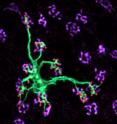UCSB scientists make advances in neuroscience and vision research
Thanks to a new study of the retina, scientists at UC Santa Barbara have developed a greater understanding of how the nervous system becomes wired during early development. The findings reflect the expansion of developmental neurobiology and vision research at UCSB. The work is described in a recent publication of The Journal of Neuroscience.
The research team examined the connectivity of nerve cells, called neurons, in mice. Neurons communicate with one another via synapses where the dendrites and axon terminals of different cells form contacts. This is where nerve signals are transmitted from one neuron to another.
Scientists have understood for some time how neuronal activation at developing synapses contributes to the patterns of connectivity observed in maturity, explained Ben Reese, senior author and professor in UCSB's Neuroscience Research Institute and the Department of Psychological & Brain Sciences.
Incoming activity plays a critical role in sculpting neuronal form and the elaboration of synaptic connections. The new research shows, by contrast, how relationships between neighboring cells of the same type independently regulate neuronal size and connectivity.
The researchers circumvented the difficulty of visualizing the three-dimensional relationships between neurons within the brain by working within the retina. The retina is an outgrowth of the brain during embryonic development, and is a precisely layered structure in which the cells, their dendrites and their axons are restricted to discrete strata. "This makes the visualization and analysis of neuronal morphology and connectivity far simpler," said Reese.
The scientists used two genetically modified mouse models to modulate the density of one particular type of retinal neuron, a class of cone bipolar cell. Cone bipolar cells relay information from the population of cone photoreceptors to the retinal ganglion cells. The latter are neurons that in turn project information to locations within the brain where further visual processing of the retinal image takes place.
The lead author on the study, Sammy Lee, was a postdoctoral researcher working in Reese's lab and supported by a C.J. Martin National Health & Medical Research Council fellowship from Australia during the course of the study. Lee labeled individual cone bipolar cells with a fluorescent dye through a new microinjection procedure developed by Patrick Keeley, a graduate student in the Reese lab.
"What Dr. Lee has shown is that cone bipolar cells modulate the size of their dendritic fields (branched extensions of the neuron) in association with the local density of like-type neurons," said Reese. "One line of mice has conspicuously fewer cone bipolar cells, each now with a larger dendritic territory, while the other line shows heightened densities and correspondingly smaller dendritic fields."
Other studies have suggested such homotypic (like-type) modulation of dendritic field size, but the current study directly shows this modulation following genetic manipulation of neuronal density, according to Reese.
Additionally, the researchers found that connectivity with the afferent population of cone photoreceptors is impacted directly, with the larger dendritic fields being innervated by more cones, and the smaller dendritic fields connecting with fewer cones. At any individual cone, the number of dendritic endings associating with that cone was not observed to change, so that the total number of connections made by a cone bipolar cell was remarkably plastic, defined solely by the number of cone contacts formed.
"This developmental plasticity in dendritic growth and synapse number may be well-suited to ensure uniform coverage and connectivity between two populations of neurons -- afferents and their targets -- when the number of cells in each population is specified independently," said Reese.
Other studies from Reese's lab, recently reported in The Proceedings of the National Academy of Sciences and Investigative Ophthalmology and Visual Science, showed how neuronal number is tightly specified genetically, yet is highly variable between different strains of mice. "Wiring together two populations, each of which may vary nearly two-fold in size, yet independent of each other, might best be served by such homotypic plasticity during early development," he said.
Studies like these may prove relevant for re-establishing connectivity following nerve cell re-specification or replacement in degenerative diseases, particularly as advances in stem cell biology make this an increasing possibility, said Reese.
Reese's research is funded by the National Eye Institute of the National Institutes of Health. In addition to clinical research NIH funds basic research furthering the fundamental understanding of biological processes; in this case, neural development.
Source: University of California - Santa Barbara
Other sources
- Scientists make advances in neuroscience and vision researchfrom Physorg13 years ago




